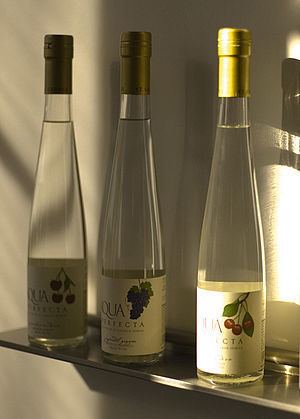 | ||
Similar Fruit, Armagnac, Calvados, Poire Williams, Kirsch | ||
Eau de vie presents the dry martini part 2
An eau de vie (French for spirits, literally "water of life") is a clear, colorless fruit brandy that is produced by means of fermentation and double distillation. The fruit flavor is typically very light.
Contents
- Eau de vie presents the dry martini part 2
- Imperial palace martini at eau de vie sydney melbourne drinks network
- Production
- Varieties
- Serving
- References
In English-speaking countries, eau de vie refers to a distilled beverage made from fruit other than grapes. Similar terms may be local translations or may specify the fruit used to produce it. Although eau de vie is a French term, similar beverages are produced in other countries (e.g., German Schnaps, Balkan rakia, Turkish rakı, Romanian țuică, Czech and Slovak pálenka, Hungarian pálinka, and Sri Lankan coconut arrack). In French, however, eau de vie is a generic term for distilled spirits. The proper French term for fruit brandy is eau-de-vie de fruit, while eau-de-vie de vin means wine spirit (brandy), and several further categories of spirits (distilled from grape pomace, lees of wine, beer, cereals, etc.) are also legally defined as eau-de-vie in a similar fashion. Many eaux de vie made from fruits, wine, pomace or rye have a protected designation of origin within the European Union.
Imperial palace martini at eau de vie sydney melbourne drinks network
Production
Ripe fruit is fermented, distilled, and quickly bottled to preserve the freshness and aroma of the parent fruit. Eaux de vie are typically not aged in wooden casks, hence they are clear. Although this is the usual practice, some distillers age their products before bottling.
Varieties
Most commonly available flavors in France are eau de vie de poire (pear)—known as eau de vie de Poire Williams when made from the Williams pear—eau de vie de pomme (apple), eau de vie de mirabelle (yellow plum), and eau de vie de pêche (peach). When made from pomace, it is called pomace brandy or marc.
While most eaux de vie from the Alpine regions of Europe only rest very briefly in glass containers, others are aged in wooden casks before bottling. Thus, calvados, an apple-based spirit from northwestern France, is required by law to spend at least two years in wood, and most producers also offer much older products to the market (up to 20 years or more). Some slivovitz are also aged in wooden casks, giving them their golden or amber color and some additional flavors.
In the Caribbean, eaux-de-vie is made from tropical fruits such as banana, ambarella, guava, mango, pineapple, and sapodilla.
The term can also refer to maple eau de vie, made from maple syrup.
Serving
Serving preferences vary. Here are some general guidelines:
